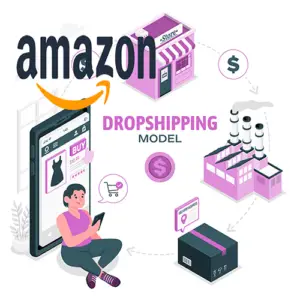Outline of the Article
- Introduction to How to Sell on Amazon Without Inventory
- Understanding Amazon’s Fulfillment Options
- Dropshipping: The Basics
- Advantages of Selling Without Inventory
- Challenges of Selling Without Inventory
- Choosing the Right Products
- Finding Reliable Suppliers
- Setting Up Your Amazon Seller Account
- Listing Your Products
- Optimizing Product Listings for SEO
- Managing Orders and Customer Service
- Monitoring and Adjusting Your Strategy
- Tips for Success
- Conclusion
Introduction to Selling on Amazon
Selling products on Amazon has become a profitable business for many entrepreneurs worldwide. With its vast customer base and robust infrastructure, Amazon offers an ideal platform for businesses to reach a global audience. Traditionally, sellers would need to invest in inventory, warehousing, and logistics to start selling on Amazon. However, with the rise of innovative business models like dropshipping, it’s now possible to sell on Amazon without holding any inventory.
Understanding Amazon’s Fulfillment Options
Amazon provides sellers with various fulfillment options, including Fulfillment by Amazon (FBA) and Fulfillment by Merchant (FBM). FBA involves sending your products to Amazon’s fulfillment centers, where they handle storage, packing, and shipping. On the other hand, FBM requires sellers to manage the entire fulfillment process themselves, including storing inventory and shipping orders directly to customers.
Dropshipping: The Basics
Dropshipping is a business model where sellers partner with suppliers who fulfill orders on their behalf. Instead of stocking inventory, sellers list products on their online store or marketplace like Amazon and forward customer orders to the supplier, who then ships the products directly to the customers. This eliminates the need for inventory management and upfront investment in stock.
Advantages of Selling Without Inventory
Selling on Amazon without inventory offers several benefits for entrepreneurs. Firstly, it allows sellers to start their business with minimal capital since they don’t need to purchase inventory upfront. Additionally, it reduces the risk of overstocking or holding obsolete inventory, thereby improving cash flow and profitability. Moreover, it offers flexibility in terms of product selection, as sellers can easily test different products without committing to large quantities.
Challenges of Selling Without Inventory
While selling without inventory has its advantages, it also comes with its own set of challenges. One of the main challenges is ensuring reliable suppliers who can consistently fulfill orders in a timely manner. Sellers also need to maintain quality control and ensure that products meet customer expectations, even though they don’t physically handle the inventory.
Choosing the Right Products
When selling on Amazon without inventory, selecting the right products is crucial for success. Sellers should conduct thorough market research to identify trending products with high demand and low competition. Additionally, they should consider factors such as profit margins, shipping costs, and supplier reliability when choosing products to sell.
Finding Reliable Suppliers
Finding reliable suppliers is essential for maintaining a successful dropshipping business. Sellers should look for suppliers who offer competitive prices, fast shipping, and high-quality products. Platforms like Alibaba, AliExpress, and Oberlo are popular choices for finding dropshipping suppliers across various product categories.
Setting Up Your Amazon Seller Account
To start selling on Amazon, sellers need to create a seller account on the Amazon Seller Central platform. The process involves providing basic information about the business, verifying identity and bank account details, and agreeing to Amazon’s terms and conditions. Once the account is set up, sellers can begin listing their products on the Amazon marketplace.
Listing Your Products
When listing products on Amazon, sellers should optimize their product listings to improve visibility and sales. This involves writing compelling product titles, detailed descriptions, and high-quality images. Additionally, sellers should use relevant keywords and optimize product attributes to enhance search engine visibility and attract potential buyers.

Optimizing Product Listings for SEO
Search engine optimization (SEO) plays a crucial role in driving traffic to product listings on Amazon. Sellers should conduct keyword research to identify relevant keywords and incorporate them strategically into their product titles, descriptions, and backend search terms. Optimizing product listings for SEO can help improve rankings in Amazon search results and increase organic traffic to the listings.
Managing Orders and Customer Service
Once products are listed on Amazon, sellers need to manage orders efficiently and provide excellent customer service. This involves processing orders promptly, communicating with customers regarding order status and shipping updates, and resolving any issues or inquiries promptly. Providing a positive buying experience can help build trust and loyalty with customers, leading to repeat purchases and positive reviews.
Monitoring and Adjusting Your Strategy
Success on Amazon requires continuous monitoring and adjustment of your selling strategy. Sellers should track key metrics such as sales performance, inventory levels, and customer feedback to identify areas for improvement and optimize their strategy accordingly. This may involve adjusting pricing, expanding product selection, or refining marketing tactics to stay competitive in the marketplace.
Tips for Success
- Build a Strong Brand Identity: Establishing a unique brand identity can help differentiate your products from competitors and attract loyal customers.
- Focus on Customer Experience: Prioritize providing excellent customer service and delivering high-quality products to ensure customer satisfaction and positive reviews.
- Stay Updated with Market Trends: Keep abreast of market trends and consumer preferences to identify new opportunities and stay ahead of the competition.
- Invest in Marketing: Allocate resources to marketing initiatives such as advertising, social media promotion, and influencer partnerships to increase visibility and drive sales.
- Continuously Improve: Be open to feedback and willing to adapt your strategy based on market dynamics and customer preferences to maintain long-term success.
Conclusion
Selling on Amazon without inventory offers a compelling opportunity for entrepreneurs to start and scale their e-commerce businesses with minimal upfront investment. By leveraging dropshipping and optimizing their selling strategy, sellers can overcome the challenges of inventory management and tap into the vast potential of the Amazon marketplace. With the right approach, dedication, and attention to detail, sellers can achieve success and build a thriving online business on Amazon.
FAQs (Frequently Asked Questions)
-
Can anyone sell on Amazon without inventory?
- Yes, anyone can start selling on Amazon without inventory by adopting a dropshipping business model.
-
How do I find reliable dropshipping suppliers?
- You can find reliable dropshipping suppliers through online marketplaces like Alibaba, AliExpress, and Oberlo, or by networking with other e-commerce entrepreneurs.
-
What are the key advantages of selling without inventory?
- Selling without inventory reduces upfront investment, minimizes risk, and offers flexibility in product selection and testing.
-
How can I optimize my product listings for SEO on Amazon?
- To optimize product listings for SEO on Amazon, focus on using relevant keywords in product titles, descriptions, and backend search terms, and optimize product attributes for maximum visibility.
-
What are some common challenges of selling without inventory?
- Common challenges include finding reliable suppliers, maintaining quality control, and managing customer expectations without physically handling the inventory.





